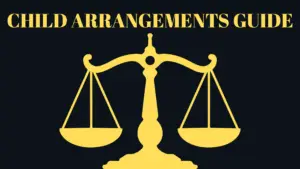My Child Wants to Change Our Contact Arrangement: A Father’s Guide
“Last Updated” Date: Friday, 10 October 2025
It’s one of the most heartbreaking moments a father can face. The Child Arrangements Order is in place, but your child—especially as they get older—starts to resist, or says they want to change the plan. It’s a moment that can feel like a personal rejection, and you may feel that you have been subjected to significant emotional discomfort, caught between enforcing a court order and respecting your child’s feelings.
This is a delicate but manageable situation that requires a calm, child-focused strategy, not a legal battle. You need to understand how the family court views a child’s evolving wishes and the steps you can take to adapt. This guide provides an authoritative roadmap, explaining the legal principles, your practical options, and how to protect your relationship with your child while navigating this challenge.
Key Takeaways
- A Child’s Wishes are a Key Factor, Not a Veto: A judge will always consider a child’s wishes, but they are just one part of the seven-point Welfare Checklist. The final decision is the judge’s.
- Age and Maturity are Crucial: The court gives significantly more weight to the clearly expressed wishes of an older, more mature child (e.g., a 14-year-old) than those of a younger one (e.g., a 7-year-old).
- Your Response is Being Judged: How you respond to your child’s wishes is critical. A parent who listens and tries to find a solution will be viewed far more favourably by the court than one who is dismissive or rigid.
- Formal Variation is the Only Safe Path: If a significant change is needed, simply agreeing to it informally is risky. You must formally apply to vary the order to make the new arrangement legally binding.
Want one-to-one guidance on this? Message us now on WhatsApp.
Jump To
- A Deep Dive: How the Court Weighs a Child’s ‘Wishes and Feelings’
- Your Strategic Path: A 4-Step Response Plan
- At a Glance: Younger Child’s Wishes vs. Teenager’s Wishes
- Common Mistakes That Can Damage Your Case
- FAQs about a Child’s Changing Wishes
From my time as a Cafcass and Children’s Services social worker, I can tell you that this issue is at the heart of many court applications. Judges and Cafcass officers are trained to distinguish between a child’s genuine, heart-felt wishes and those that are the result of parental influence. The first thing they will look for is whether the parents have truly listened to the child.
A Deep Dive: How the Court Weighs a Child’s ‘Wishes and Feelings’
The ‘Wishes and Feelings’ Clause
The “ascertainable wishes and feelings of the child” is the first factor of the Welfare Checklist, found in Section 1 of the Children Act 1989. The court has a duty to consider what the child wants, but this is always done “in the light of his age and understanding.”
What This Means For You: This means the court will listen, but it is not bound by what your child says. A judge will try to understand the reasons behind their wishes. Are they genuine? Are they being influenced? Is it a temporary whim or a deeply held conviction?
The Sliding Scale of Influence
There is no magic age at which a child’s decision becomes final, but the court operates on a sliding scale. While not a direct family law term, the principle of ‘Gillick Competence’ is relevant: as a child’s age and maturity increase, so does the weight the court gives to their autonomous views.
What This Means For You: A court is highly unlikely to force a 1-5-year-old to have contact against their strong and consistently expressed wishes. Conversely, a court is much more likely to rule that it is in a 9-year-old’s best interests to continue contact, even if they are saying they don’t want to go.
Example: Snippet from a Position Statement Acknowledging a Child’s Wishes
I acknowledge that my daughter, [Child’s Name] (aged 14), has expressed a wish to reduce her overnight contact from every other weekend to one weekend a month.
I have listened to her reasons, which are primarily focused on her desire to spend more time with her school friends on weekends. This is a normal part of her social development, which I fully support. A copy of our recent text conversation discussing this is at Exhibit A.
However, I am concerned that reducing contact so significantly would negatively impact our relationship. As a compromise, I have suggested that we move to a schedule of one overnight weekend a month, but that we also arrange a mid-week evening activity together (e.g., cinema, dinner) on the alternate weeks.
I believe this proposal respects my daughter’s evolving independence and social needs, while still ensuring our father-daughter relationship is consistently nurtured, in line with the Welfare Checklist.
A Real Life Scenario: Sarah’s 13-year-old son, Tom, started refusing to go for contact with his dad, Mark. Mark was hurt and angry, and initially tried to force him. This made things worse. After seeking advice, Mark changed his approach. He sat down with Tom and listened, acknowledging that his son’s social life was now a major priority. Together, they agreed on a new plan: fewer full weekends, but more flexible evening and holiday time. Mark then proposed this to Sarah in a calm email. They agreed to the changes and formalised them with a simple consent order, avoiding a contested court battle and repairing Mark’s relationship with his son.
Your Strategic Path: A 4-Step Response Plan
When your child wants to change the arrangement, your response is critical. Follow these steps to handle the situation constructively.
- Listen and Understand (Don’t Interrogate): Your first job is to be a dad, not a lawyer. Sit down with your child in a calm moment and listen to their reasons. Ask open questions like, “What would your ideal weekend look like?” The goal is to understand their feelings, not to challenge them.
- Communicate with the Other Parent: Once you understand the issue, raise it with your ex-partner in a neutral, child-focused way. Start with, “I’ve been speaking to [Child’s Name], and it seems they’re feeling…” Propose working together to find a solution.
- Consider Mediation: If you can’t agree, the next step is formal mediation. A neutral third party can help you both explore options and compromises that respect the child’s wishes while maintaining your involvement.
- Apply to Vary the Order (If Necessary): If all else fails, you may need to apply to the court. For a detailed guide on the procedure, see our article on how to apply to vary a child arrangements order.
At a Glance: Younger Child’s Wishes vs. Teenager’s Wishes
The court’s approach changes dramatically with the age of the child. Here’s how a judge is likely to view the situation.
| Feature | Younger Child (e.g., 7-11) | Teenager (e.g., 14+) |
|---|---|---|
| Goal | ✅ To understand the child’s feelings, but primarily to ensure stability and the benefit of a relationship with both parents. | ❌ To respect the teenager’s growing autonomy and find a practical arrangement that they will actually adhere to. |
| Court’s View | Wishes are heard but are seen as less reliable and more susceptible to influence. The ‘benefit of contact’ often overrides the child’s stated wish. | Wishes are given significant, often decisive, weight. The court knows it cannot physically force a teenager to attend contact. |
| Example | An 8-year-old says they “don’t want to go” because they miss their mum. A judge is likely to maintain the contact schedule. | A 15-year-old wants to stop overnight contact to focus on GCSEs and a weekend job. A judge is very likely to agree. |
| Legal Test | The judge will rely heavily on the other six factors of the Welfare Checklist to determine what is truly in the child’s best interest. | The judge’s main test is whether the teenager’s wish is genuine, rational, and not the result of alienation or harm. |
| Outcome | ✅ The court is more likely to enforce the existing order or make only minor changes. | ❌ The court is likely to vary the order to reflect the teenager’s wishes, perhaps ordering less direct contact. |
Avoid costly mistakes — chat with us today and get practical, fixed-fee support.
Common Mistakes That Can Damage Your Case
When writing Section 7 reports, I often saw fathers make the same mistakes when faced with a child’s resistance. How you react is a test, and the court is watching.
Common Pitfalls:
- Blaming the Other Parent Immediately: Why this is a mistake: While parental alienation can be real, your first assumption should not be that your child is being manipulated. Dismissing their feelings as “not their own” tells the court you are not listening to your child.
- Trying to “Enforce” the Order: Why this is a mistake: You cannot physically force a child to attend contact. Trying to do so will traumatise the child and will be viewed extremely poorly by the court. Your only enforcement mechanism is the court itself.
- Ignoring the Problem: Why this is a mistake: If your child is consistently refusing contact and you do nothing, you are tacitly accepting a new status quo. The longer this goes on, the harder it is for a court to re-impose the original arrangement.
FAQs about a Child’s Changing Wishes
This is a sensitive topic, and fathers often have urgent questions. Here are the clear answers you need.
At what age can a child decide who they want to live with in the UK?
There is no specific age in UK law where a child can decide. However, as a general rule, the court will give significant weight to the views of a child from the age of 12-13, and the views of a child aged 14 or over are often the decisive factor, provided they are mature and their reasons are rational.
What if I think my ex is turning my child against me (parental alienation)?
Parental alienation is a very serious issue. If you suspect this is happening, you must raise it with the court in your application. The court will likely order a CAFCASS report to investigate the reasons for the child’s wishes. You must provide evidence, not just accusations.
Can a court force a teenager to see their father?
Legally, a Child Arrangements Order is enforceable until the child is 16. In practice, a court is extremely reluctant to make an order that it knows a 14 or 15-year-old will defy. The court cannot physically force a teenager to go, so it will usually try to find a compromise or vary the order to reflect their wishes.
What if my child wants to change contact because I’m moving house?
This is a common reason for a child’s wishes to change, especially if the move increases travel time. The court will consider this a valid issue and will expect both parents to work together to find a practical solution. The responsibility is on the moving parent to propose a realistic and sustainable plan for future contact.
My son/daughter just wants to play with their friends on weekends. Is that a valid reason?
Yes. For an older child or teenager, the court sees their social life and independence as a vital part of their development. A judge is very likely to see this as a valid reason to want to change an old, rigid contact schedule. A parent who shows flexibility on this issue will be viewed favourably.
Navigate This with a Child-Focused Strategy
At Dads Consultancy, we provide the specialised, expert support to move you from crisis to control. We can help you with:
- Handling the CAFCASS Call
- Navigating Section 7 Reports
- Drafting Powerful Position Statements
- Making Your Application (C100)
- Navigating Child Arrangements Orders
- McKenzie Friend Support
- MIAM/Mediation Guidance
- Responding to Non-Molestation Orders
When your child wants to change contact, your relationship is at a critical juncture. A heavy-handed legal response can cause lasting damage. WhatsApp us today for a fixed-fee consultation to build a calm, sensitive, and child-focused strategy that protects your bond.
🧠 Insider Insight: Lach, our founder, is a former Cafcass and Children’s Services Social Worker. He has been on the inside of the family court system, writing the very reports that influence court outcomes. Now he uses that insider knowledge to help dads navigate the process effectively. Learn more about Lach’s background.




